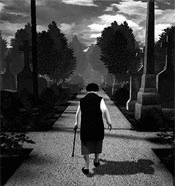"Does interactivity stand in the way of depth, of thoughtfulness?" This question appears on a recent post to the blog of Tale of Tales, the Belgian game development studio of Auriea Harvey and Michaël Samyn; their latest project addresses this very notion. The Graveyard is a small but lovingly detailed black-and-white 3D game with a simple but compelling premise: you navigate an old woman, hobbling with excruciating slowness on her cane, through a shadow-dappled pathway in a cemetery, approach a bench on the edge of a chapel, and allow her to sit and rest. Once the woman sits, the game switches to a more non-interactive mode: her face is superimposed in close-up on half the screen, while a somber three-and-a-half minute song plays, its lyrics pondering the vicissitudes of mortality. The player may then have the woman stand up, and slowly shuffle out of the cemetery, ending the game. (The free trial version and the $5 full version differ in one respect only: in the full version, the woman may die at any moment, her head bowing down and cane dropping to the ground. When I played the game, she died during the song, remaining on the bench afterwards for a seemingly interminable amount of time until I manually quit the application.) Like Teller of Tales's non-violent all-deer MMORPG The Endless Forest, The Graveyard sits on the borderlands between new media art and indie gaming, where its designers seem at home: in their Realtime Art Manifesto, they urge art-game creators to "reject conceptualism" and "make art for people, not for documentation. Make art to experience and not to read about." In The Graveyard, interactivity may not stand in the way of thoughtfulness, but does so by altering our accepted sense of game-time: its extremely limited set of input options, starkly impeded pace and an extended cinematic section in which the player can do nothing but sit back, watch and listen all contribute to this contemplative experience. - Ed Halter
